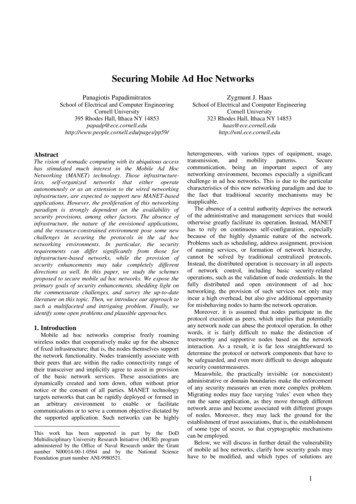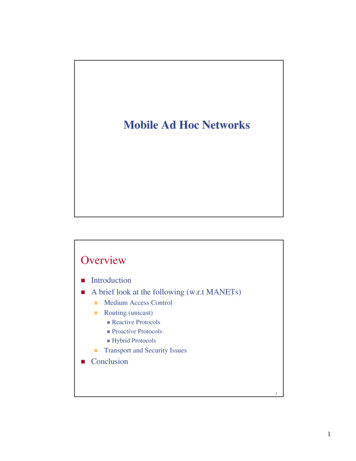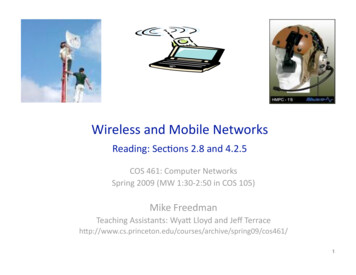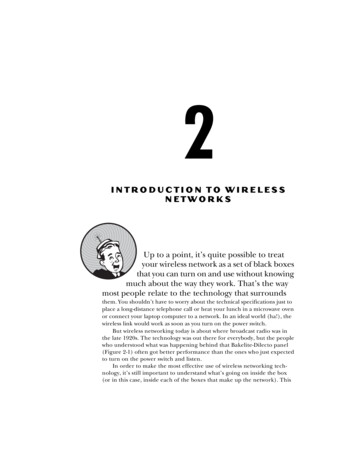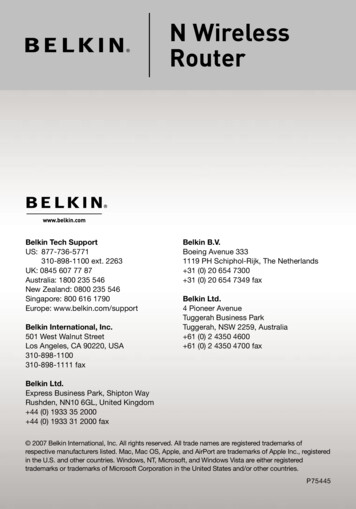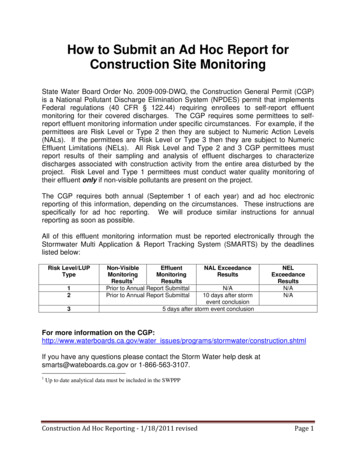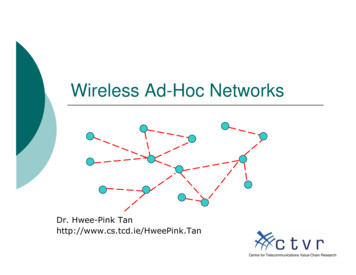
Transcription
Wireless Ad-Hoc NetworksDr. Hwee-Pink Tanhttp://www.cs.tcd.ie/HweePink.TanCentre for Telecommunications Value-Chain Research
Outline – Part 1 MotivationWireless Ad hoc networks Comparison with infrastructured networksBenefitsEvolutionTopologiesTypesClass exerciseCentre for Telecommunications Value-Chain Research
Knowledge is life!Trafficaccidentoriginal routeCentre for Telecommunications Value-Chain Research
Car-to-car communicationTrafficaccidentoriginal routenew routeSource: www.car-2-car.orgCentre for Telecommunications Value-Chain Research
Car-to-car communication Enables communication between eachcar and its environment Reduction of traffic riskDrive-thru check-in at airportForward travel info / music from living roomPC to carReceive modified itinerary from yourcompany at petrol station to save timeSource: www.car-2-car.orgCentre for Telecommunications Value-Chain Research
Wireless Ad Hoc Network (WAHN) Each node can only communicate with another node ifthere is a link between them (communication range)Source: www.car-2-car.orgCentre for Telecommunications Value-Chain Research
Wireless Ad Hoc Network (WAHN) Infrastructured networks Comm. through base station (BS)Single-hopCentralized management at BSLong-term comm. needsHomogeneous devices WAHN Peer-to-peer communicationMulti-hop, relayDistributed managementShort-term, on-the-flyHeterogeneous devicesCentre for Telecommunications Value-Chain Research
Characteristics of WAHN Advantages Quick and inexpensive to setupExtends range and reduces power consumptionthrough multihop comm.Disadvantages Traditionally viewed for military useDifficult to build business model for profitgeneration for operatorsDifficult to guarantee quality of serviceRequires node cooperationCentre for Telecommunications Value-Chain Research
Evolution of WAHN Packet radio networks (DARPA, 73)To enable comm. inmobile environment Broadcast radios Packet-switchedStore-and-forwardHeavy andexpensiveHigh powerLow processingcapabilityNot scalable androbust!Centre for Telecommunications Value-Chain Research
Evolution of WAHNPacket radio networks (DARPA, 73) Comm. in mobileenvironment ScalableRobust in hostileenvironmentSurvivable radio networks (DARPA, 83) Radios Small and low costLow powerHigh processingcapabilityCentre for Telecommunications Value-Chain Research
Evolution of WAHN Packet radio networks (DARPA, 73)Portable devices(e.g., laptops, PDAs) Survivable radio networks (DARPA, 83) Radio cards 802.11 / Wi-Fi networks (IEEE, 90s)Peer-to-peerconnectivityConsumerelectronics andgaming applicationsSmall and low costLow energyconsumptionHigh processingcapabilityCentre for Telecommunications Value-Chain Research
WAHN topologiesHub Star-topology Good performanceEasy to setup and scalableBottleneck at hubExamples Bluetooth piconetsCellular networksMesh-topology Highly ReliableDifficult to setupNon-scalableExamples Community networksCentre for Telecommunications Value-Chain Research
Types of WAHN Wireless Personal Area Networks (WPAN) Mobile Ad-Hoc NETworks (MANET) Network of mobile routers (relay)Wireless Sensor Networks (WSN) Interconnects devices centered around anindividual's workspaceRemote network of sensing devices for monitoring /detection of phenomenaWireless Mesh Networks (WMN) Highly-reliable mesh of cooperative nodes to extendnetwork reachCentre for Telecommunications Value-Chain Research
WPAN [IEEE 802.15.x] Salient features Direct (Single-hop) comm.Standalone networkSupported devices Fixed (printer, desktop) Portable (cellphone, PDA,mp3 player etc)Example technologies BluetoothIrDAZigBeeCentre for Telecommunications Value-Chain Research
Comparison of WPAN technologiesTechnologyBluetoothIrDAZigbeeAppn focusCable replacementRemote, largescale controlComm.MediumRF, ISMInfra RedRF, ISMData rate1 Mbps4 Mbps250 kbpsRange 10m1m 70mPowerconsumptionLowVery lowVery lowCostLowVery lowVery lowMobilitysupportGoodPoorGoodCentre for Telecommunications Value-Chain Research
MANETs Salient features Dynamic topology (due to high mobility)Energy-constrained operationStandalone or extension of fixed networkExample technologies Vehicular Ad-hoc NEtworks (VANET) Car-2-car communicationsWireless broadband emergency / public safetynetworkCentre for Telecommunications Value-Chain Research
WSN [Underwater Sensor Networks] Submarine detection for Naval / Maritime patrolCentre for Telecommunications Value-Chain Research
Wireless Sensor Networks Salient features Remote, large scale deploymentRF / Sonar communicationsHarsh environmentSize- and energy-constrained sensorsFailure-prone sensorsExample applications Environment and habitat monitoringUnderwater sensing (seismic / oil-spills)Battlefield surveillanceWireless Sensors Enterprise led Networks[WiSEN] www.tyndall.ie/projects/wisenCentre for Telecommunications Value-Chain Research
Wireless Mesh Networks Salient features Highly reliable (meshstructure)Based on 802.11Cooperative relaynodes (internationalpostal agreement)Extend networkreach (e.g., Internet)Example Wireless communitynetworksCentre for Telecommunications Value-Chain Research
Wireless Community Networks Development of interlinked citywide or city-ruralnetworks to extend Internet reach Based on 802.11Hobbyist (voluntary)-led and non-profitManaged by community using the network School, neighborhood, small businessesExamples IrishWAN [Clare, Limerick, Galway and SE region] http://www.irishwan.comCorkWAN [Cork] http://www.corkwan.org/Centre for Telecommunications Value-Chain Research
Time for some brainstorming. Think of a application scenario forwireless ad-hoc networking Bear in mind the following: Salient featuresAdvantages / disadvantagesWhy not infrastructured?Centre for Telecommunications Value-Chain Research
Wireless Ad-Hoc NetworksDr. Hwee-Pink Tanhttp://www.cs.tcd.ie/HweePink.TanCentre for Telecommunications Value-Chain Research
Outline – Part 1 MotivationWireless Ad hoc networks Comparison with infrastructured networksBenefitsEvolutionTopologiesTypesClass exerciseCentre for Telecommunications Value-Chain Research
How does it work?Trafficaccident How is the ad hoc network formed?How to propagate information in the best wayover the network?Source: www.car-2-car.orgCentre for Telecommunications Value-Chain Research
Outline – Part 2 How do ad-hoc networksfunction? RoutingMedium Access ControlPower controlPerformance metricsCentre for Telecommunications Value-Chain Research
How does it work?Fully connectedSingle hopLow network capacityDisconnectedHigh network capacity Power control ConnectedMulti-hopGood network capacityWhat is the best transmit power for desired Connectivity Topology Network capacityCentre for Telecommunications Value-Chain Research
How does it work?DS Routing What is (are) the best path(s) from source (S)to destination (D)?Depends on design criteria, e.g., delay,energy, throughput etcCentre for Telecommunications Value-Chain Research
How does it work?DDSS Another source-destination pairMedium Access Control (MAC) Who transmits when?Centre for Telecommunications Value-Chain Research
Classification of routing protocols Table-driven routing [DSDV] Each node maintains consistent, up-to-dateroutes periodic updates in response to topology changesUseful for datagram (bursty) trafficHigh signalling traffic and power consumptionWastage in maintaining routes never usedOn-demand routing [DSR] Creates route(s) only when source needsHigh latencyLow signalling trafficCentre for Telecommunications Value-Chain Research
Ad Hoc Routing protocols Hybrid table-driven / on-demand routing Hierarchical routing Nodes clustered according to relative proximityInter-/intra-cluster routingSuitable for large networksGeographic routing Zone Routing Protocol [ZRP]Node geographically closer to destination chosen asnext hopPower-aware routing Transmit over shorter distance / more hops to saveenergyCentre for Telecommunications Value-Chain Research
Desirable characteristics Distributed operationLoop-freeDriven by bottleneck Bandwidth/energy - on-demandDelay - table-drivenSecuritySleep-period operationSupports uni-directional (assymmetric)linksCentre for Telecommunications Value-Chain Research
Carrier Sense Multiple Access (CSMA)ACXB Node A wants to communicate with node BNode A physically senses the channel and deferstransmission if channel already in use Node A won’t transmit since it detects Node C’stransmissionALOHA, n-persistent algorithmsCentre for Telecommunications Value-Chain Research
Hidden-node problemDDSABCS Node A is communicating with node BNode C also wants to comm. with node B Node C senses that channel is availableCollision at node B because node A is hidden fromnode C!Centre for Telecommunications Value-Chain Research
Exposed-node problemDADSBCD SNode B is communicating with node ANode C wants to communicate with node D Node C refrains from transmitting since it sensesnode B’s transmission even though NO collision willoccur otherwise!Centre for Telecommunications Value-Chain Research
Medium Access Collision Avoidance(MACA)DSDRTSDataBACTSCCTSS Virtual sensing via Request-to-send (RTS) / Clearto-send (CTS) handshake Nodes that overhear CTS not in response to its RTS(RTS not from its intended recipient) refrain fromtransmitting (will transmit)Centre for Telecommunications Value-Chain Research
Medium Access Collision Avoidance(MACA)DARTSDDataRTSSBCTSCD SVirtual sensing via Request-to-send (RTS) / Clearto-send (CTS) handshake Nodes that overhear CTS not in response to its RTS(RTS not from its intended recipient) refrain fromtransmitting (will transmit)Centre for Telecommunications Value-Chain Research
Classification of MAC protocols Contention-based vs scheduled Single vs multi-channel system Flat vs clustered structure Omnidirectional vs directional antenna Solution to hidden / exposed nodeproblem?Source:www.utdallas.edu/ mxw013200/MAC ADHOC.htmlCentre for Telecommunications Value-Chain Research
Power control protocols Optimal transmit power to controlconnectivity properties Power-aware routing Power-aware MAC Joint power-aware routing/MACCentre for Telecommunications Value-Chain Research
Performance metrics End-to-end throughput / delay Route acquisition time % out-of-order delivery Efficiency (overhead) Fairness Energy efficiencyCentre for Telecommunications Value-Chain Research
Summary What is a wireless ad hoc network? (WAHN) Types of WAHN FeaturesBenefitsPersonal area networksMobile ad hoc networksSensor networksMesh networksHow does a WAHN work? Power controlRoutingMedium access controlPerformance metricsCentre for Telecommunications Value-Chain Research
Useful links Wikipedia Routing www.cs.ucsb.edu/ ebelding/txt/review.psMedium access control en.wikipedia.org/wiki/Ad hocwww.utdallas.edu/ mxw013200/MAC ADHOC.htmlPower control black.csl.uiuc.edu/ prkumar/ps files/compow ewc2002.pdfCentre for Telecommunications Value-Chain Research
Time for some brainstorming. Are the hidden / exposed node problemssolved completely with MACA? Ans: No! Think of scenario(s) where MACA fails toprevent CollisionInefficiencyCentre for Telecommunications Value-Chain Research
InefficiencyDDRTS/DataSABCTSRTSCXCTS DSNode A is communicating with node BNode D wants to communicate with node C Node C refrains from transmitting CTS since it hearsnode B’s CTS even though NO collision will occurotherwise!Centre for Telecommunications Value-Chain Research
CollisionDRTS/DataADRTSSBRTSCTSCCTS DSNode B is communicating with node ANode C wants to communicate with node D Node D’s CTS may collide with RTS from node B at node CNode C may not get to transmit to node DCentre for Telecommunications Value-Chain Research
Ad Hoc Routing protocols Hybrid table-driven / on-demand routing Zone Routing Protocol [ZRP] Hierarchical routing Nodes clustered according to relative proximity Inter-/intra-cluster routing Suitable for large networks Geographic routing Node geographically closer to destination chosen as

